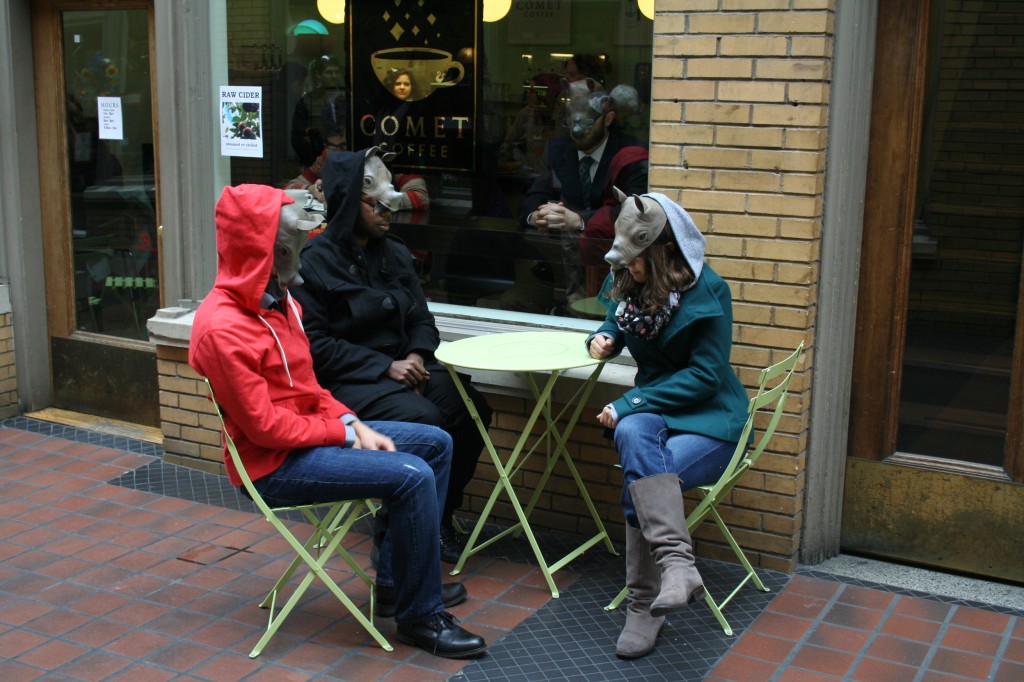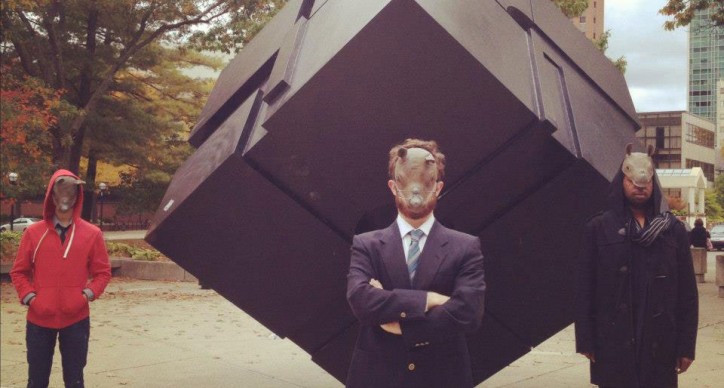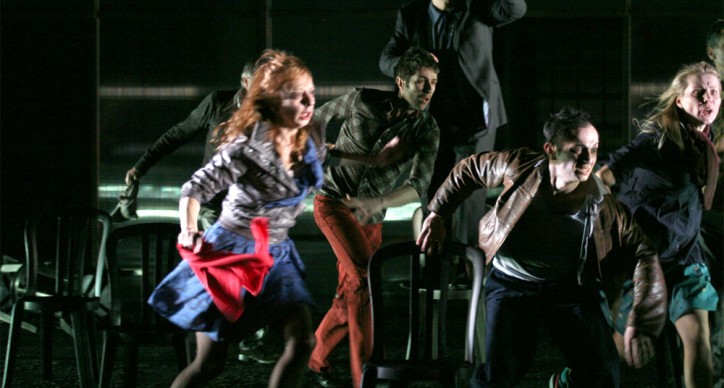Rhino as Participant
Utilizing the expertise and enthusiasm of odd-toed herbivores in the family Rhinocerotidae to invite participatory experiences with the performing arts.
We all have work heroes. Someone our career-selves aspire to be, someone whose philosophies resonate with us on a personal and a professional level. My work hero happens to be Nina Simon, author of The Participatory Museum.
Nina’s philosophy, paraphrased Truly-style, is this: if a cultural institution wants to maintain relevancy, it has to stop treating audience members as passive faces in the crowd and start inviting and utilizing community collaboration, participation, and expertise.
Every community member has something special to bring to the table — be it a doctoral thesis or a really great Netflix recommendation — and thanks to social media, we’ve all grown accustomed to sharing. Simply put: cultural experiences that “stick” for many of us are those that allow us to do something hands-on.
So what does this mean for UMS? It means the umsLOBBY. It means Tweet Seats. It means UMS Night School. It means the UMS Student Committee. It means Rhinos.
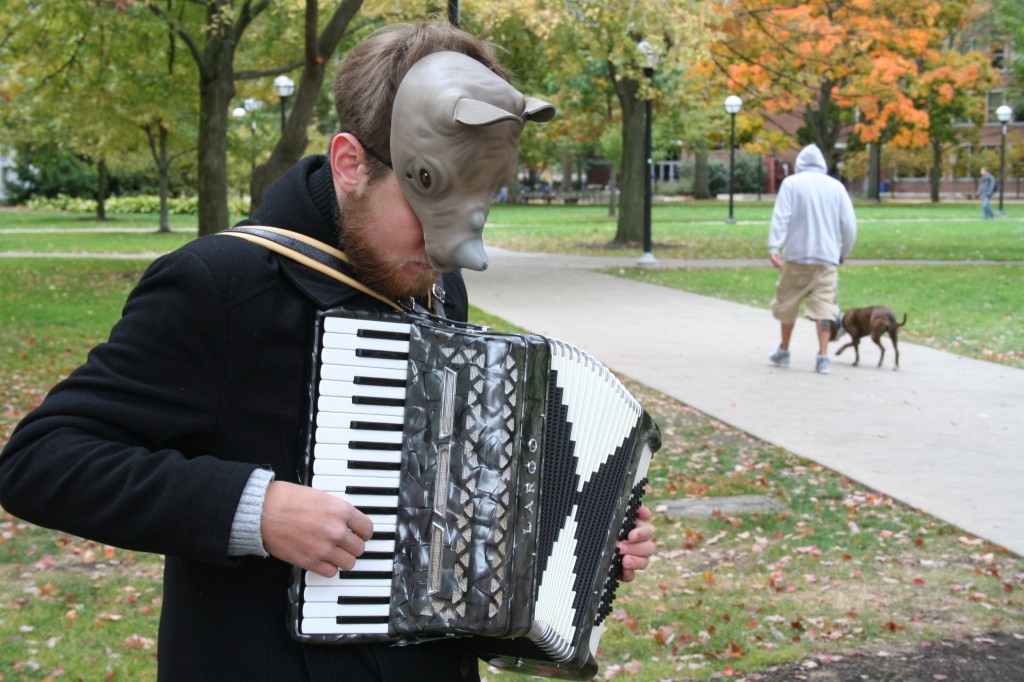 In order to understand the Rhino Project, you’ve got to get to know the UMS Student Committee. An official University of Michigan Student Organization, this committee works tirelessly to promote student engagement in the performing arts on campus. Comprised of roughly 30 student volunteers, UMS works closely with this group to plan and execute our student Arts & Eats events, design and create UMS advertisements and represent UMS to the student population in a variety of other ways.
In order to understand the Rhino Project, you’ve got to get to know the UMS Student Committee. An official University of Michigan Student Organization, this committee works tirelessly to promote student engagement in the performing arts on campus. Comprised of roughly 30 student volunteers, UMS works closely with this group to plan and execute our student Arts & Eats events, design and create UMS advertisements and represent UMS to the student population in a variety of other ways.
This October (11-13), UMS presented the Parisian theater company, Théâtre de la Ville, performing Ionesco’s Rhinocéros. If you didn’t have the pleasure of seeing this production at the Power Center while it was in town, the play was influenced by Ionesco’s time in Romania as a young man, when nearly everyone around him converted to fascism. Being the theater of the absurd classic that it is, replace “fascist” with “rhino” and you’ve got Rhinocéros.
The UMS Student Committee really got behind the concept of a real-life rhino occupation. Equipped with rhino masks and flyers, students took to the streets and for the two weeks leading up to the Théâtre de la Ville performance, rhinos invaded Ann Arbor.
My favorite part of this project was watching the students really run with the idea and take it to entirely new levels. During the campaign, students became actors, buskers, art directors, photographers, and social media animals. Using their expertise and natural enthusiasm, the UMS Student Committee took the campaign and really made it their own.
Sure, the campaign worked for UMS on a purely promotional level but more importantly it invited deep, meaningful participation and collaboration from the students on campus. This is the kind of project that might even make Nina Simon proud. Plus, Théâtre de la Ville loved it. The actors clamored for souvenir rhino hats and the management requested images of our rhinos to be used in company communications efforts.
Rheme Sloan, UMS Student Committee President, did a fabulous job of getting buy-in for the campaign from the students and organizing the efforts on campus. UMS Marketing Intern Anna Piotrowski did a great job of rhino-acting herself and organizing other layers of the rhino campaign, including postering and sidewalk stenciling.
Here, Rheme and Anna talk about what it was like to be a rhino and what this type of participatory project means for student engagement.
UMS: Please introduce yourself. What’s your role at UMS? What interests in you in performing arts?
Rhemé Sloan: I am a junior Voice Performance Major in the School of Music, Theatre, & Dance. I am a Marketing Intern for UMS as well as the President of the UMS Student Committee. I live for the performing arts. They challenge me to think outside of my own world and explore the beauty in all things.
Anna Piotrowski: My name is Anna Piotrowski, and I’m a junior Violin Performance Major with a Performing Arts Management Minor at U-M. This is my first year as a marketing intern at UMS. Since I have been playing the violin for 15 years, I definitely have a passion for the performing arts. I’ve always enjoyed going to a variety of concerts and performances where I can see or hear something that I’ve never encountered before.
UMS: Could you describe your role in the recent Rhinoceros guerrilla marketing campaign?
RM: I was in charge of organizing all the volunteers who went around Ann Arbor and U-M in rhino masks. At several happenings we had photographers come out and take pictures so it was crucial to make sure we had solidified plans. I also organized and participated in the photo shoot that took place at landmarks across central campus. We had a blast taking those photos.
AP: I was in charge of creating a “street team” of 10 people to cover the campus sidewalks with spray chalk Rhinoceroses, as well as getting volunteers to post different flyers promoting the performance. We had a political style campaign poster as well as a traditional informational poster that were posted.
UMS: What did you like about this campaign? What were some surprises along the way?
AP: I liked the mystery behind this campaign – the Rhino masks and spray chalk stenciling and vague political posters were all very attention getting and got people talking! I also liked that it was accompanied with other tactics that were more informational, so people could really get a sense for what type of performance this would be.
RM: I loved how innovative and weird the campaign was. When my supervisor first told me about this project I’m sure my face read “You all must be out of your mind.” But when I saw the posters I was filled with glee because I had never seen anything like it. The biggest surprise along the way was the Saturday morning we did the photo shoot around campus. We had finished taking pictures in Nickels Arcade and were walking across the street to take pictures with this guy playing the accordion. To our disbelief this random accordion player was wearing a rhino mask and had our “Rhino is Listening” flyers in his money box. We couldn’t believe what was happening.
UMS: What kind of a response did you get from other students about this campaign or the performance?
AP: Other students seemed to be excited and willing to participate in this campaign. There were many different ways that students could help out and I think that everyone found something they could enjoy.
RM: Students responded positively to the rhino campaign. We did our best to make Rhino as visible across campus as we possibly could and I think we were very successful. Once the tour came to town there was so much hype around the show and students’ expectations were very high. I think the show really rose to the occasion and many found it very relevant during this election season.
UMS: Did you have the chance to go to the performance? If yes, did working on this campaign affect your experience of the performance?
AP: I did see the performance, and working on the campaign definitely affected how I experienced the performance. It gave me background knowledge of the plot and history of the play, among other things. Working on the campaign also allowed me to go into the performance with a good basic knowledge of what to expect in terms of style, genre, and themes, while still retaining a level of uncertainty as to how it will be delivered. Over all, working on the campaign was a positive contribution to my viewing experience.
RM: I went to the last performance of Rhinocéros. Having worked on the campaign I knew to expect something incredible and major and the show totally delivered. It was difficult to get a full grasp of the play since I was hearing it for the first time in French, but the action and storytelling was so on point that it didn’t matter. Now all I have to do is read it in English!
Check out the November issue of The Ann Magazine for more on this campaign!
Did you see rhinos around town? Would you like to see more campaigns like this one?
Tweet Seats 2: Théâtre de la Ville: Ionesco’s Rhinocéros
Editor’s note: This season, UMS is launching a new pilot project: tweet seats. Read the complete project description and pre-interviews with participants here.
For the second tweet seats event, we saw Théâtre de la Ville: Ionesco’s Rhinocéros:
This week’s participants:
- Paul Kitti, writer for iSPY magazine
- Greg Baise, Detroit-based concert promoter, arts writer, and DJ
- Leslie Stainton, U-M School of Public Health Findings magazine editor and umslobby.org contributor
- Mark Clague, U-M Associate Professor of Musicology and UMS Board member
- University of Michigan social media intern Mollye Rogel
- Michael Kondziolka, UMS director of programming, scheduled to tweet at this event, was not able to participate. See his note about why below.
Read the whole tweet seats conversation here.
UMS: So, how did tweeting affect your experience of this performance?
Paul Kitti: For this particular performance, tweeting was most often on the back burner for me. It was impossible to tweet without missing something, as the performance was in French with surtitles (and I only know about three words in French…) The outcome, which I expected, was that I enjoyed the play as well as the twitter conversation, but the dialogue I missed in the process left some holes in the experience.
Greg Baise: I found myself thinking of tweets, but waiting for lulls to post them. Some tweets got away because I was deep into the play. Initially I was concerned that my tweeting activity would be a distraction to others. It turns out it was more of a distraction to myself!
Mark Clague: I was surprised by the conversational quality of tweeting Rhinoceros. Since we were reacting to a provocative narrative characterized by inference, juxtaposition, and an epic sense of language that seemed immediately referential and symbolic, many of the tweets searched for meaning. I paid attention to the hashtag and responded to several of the other tweet experimenters, but also to a couple of friends who either attended or just reacted to my observations. One such interchange led to a couple rounds of comments and ultimately intractable disagreement in interpretation. I found myself musing on the disagreement for days afterward and discussing the show face-to-face with another friend to clarify my own understanding. I didn’t change my mind and still prefer a more open interpretation connected to contemporary events, but my commitment to that understanding is richer and deeper for the tweets. Another thing I liked is that a question occurred to me the next day and I could tweet @UMSNews to get my question answered — YES, the set was transported from Paris to Ann Arbor. Finally, I attended the play a second time the next night and did not tweet. My experience was different — I became aware of how many people were speaking French in the audience. I don’t speak French, but gradually improved my understanding of the actors as the play progressed. Also, I sat in row 8 or so close to the stage, rather than tweeting from the back of the balcony. The emotional intensity of the play was much higher sitting so much closer. I was engaged both nights: the first felt a bit more intellectual (tweeting the show in this situation felt like taking notes at an exciting lecture) while the second was more raw and emotional. I’m guessing that my experience on night #2 was richer for having “researched” the play the evening before.
Leslie Stainton: If anything, this second experience of tweeting only confirmed my earlier antipathy to the form (if that’s the right word). It probably didn’t help that I saw the show near the end of the work week and after a glass of wine, so the dim lights and French dialogue and stratospheric tweet seats combined to send me into a bit of a nap. I felt oddly detached from the performance, and I suspect part of that had to do with the isolation I now associate with tweeting live theater. You’re apart from the crowd, with your little black box and too-bright phone. The production itself was gorgeous, provocative, beautifully acted, deeply meaningful. Some of this came together for me at the end, when I really did wake up with a “pow” and suddenly wished I could see it again, without the filter of tweets, and certainly from a better seat than the ones we had. (Didn’t bother me nearly so much with Aspen-Santa Fe, but this production needed to be seen up close, I think.) What “stuck” from the experience is my realization that I don’t want to tweet again–as I said to someone on my way out, I’d prefer to keep my brain farts to myself next time. But thanks for the experiment, and thanks to UMS, as always, for going about this so intelligently and carefully. And thanks for making it possible for those who DO get something out of this medium to keep at it.
Michael Kondziolka: I bailed on my commitment to be a tweet seater last night. Not because I didn’t want to try it out, but because if became clear that the General Manager of Théâtre de la Ville and the US tour producer of Rhinocéros wanted to sit with me at the opening night performance. I didn’t want to run the risk of offending anyone by creating a moment of “cultural misunderstanding.” After the show, I mentioned this to them both and they were, not surprisingly, first a little put off by the whole notion of tweet seats and, after more conversation, intrigued. I shared the tweet stream with them…and they seemed to like it. Interestingly, there seems to be very little commitment or conversation at the moment in Paris around the role of social media in connecting with audiences OR in building or attracting new audiences. At least this seems to be the case at TdlV. The GM of TdlV wanted as much information on the topic as I could give him…clearly he knows that he needs to look at these issues very seriously. Imagining what the experience of tweeting during last night’s performance would have been like gives me a rash. The complexity of the show…the layers of meaning and metaphor embedded in the text….how that meaning is delivered through the force of the acting and physical performance…PLUS the reading of super-titles (my French is only so-so)…was a lot to take in and make sense of from time to time. The idea of another layer — the processing of my thoughts and experiences and transmitting them in real time on a little illuminated keypad with my thumbs in real time — might have sent me around the bend. But I am still willing to try at an upcoming show!!
UMS: What do you think makes for a performance “sticky” (the performance “sticks” in your memory months or years later)? Do you think live tweeting a performance make it more or less likely to be “sticky”?
Molly Roegel: The quality of a performance in terms of acting, directing, music and set design, makes it “sticky” for viewers, as well as the relevance to them and how much they can personally understand. Live tweeting made this performance far less sticky to me as I could not pay attention to the subtitles, Instagram, Twitter, and the actual performance in any sort of way that would have allowed me to get the full experience of the play. I greatly enjoyed live tweeting but it was definitely not conducive to gaining the full scope of the play.
Mark Clague: Tweeting Rhinoceros has certainly made the experience more memorable or “sticky” for me. Four days later I can remember specific lines of dialogue and the emotion of the play remains vivid. I’ve had several conversations about the play with friends inspired by my twitter exchanges and reviewed my tweets archived on Twitter.com to review the performance, which reminded me of several personal responses that had begun to fade. Tweeting the show is definitely a source of distraction — I’m watching my cell phone screen at times rather than the stage. However, it’s not like I avoided all distraction the next night when I wasn’t tweeting on assignment. For the most part, I found that tweeting enhanced my attention and put me in a mindset to parse and understand the show. If the purpose of art is to get us to think and to think in unexpected ways, Twitter seems (for me at least) to serve this goal. If tweeting an art experience were to become more routine and typical, I wonder if some sort of compromise that takes the best of both my night 1 & 2 experience would be possible. One could tweet intermittently and engage with a broader conversation as the show inspired it. The brevity of Twitter leads to an immediacy and directness that might balance emotional reaction with analytical understanding.
Stay tuned for the next tweet seats event: Mariinsky Orchestra of St. Petersburg on Saturday, October 27.
How do you feel about using technology during live arts experiences?
Théâtre de la Ville at the Michigan game
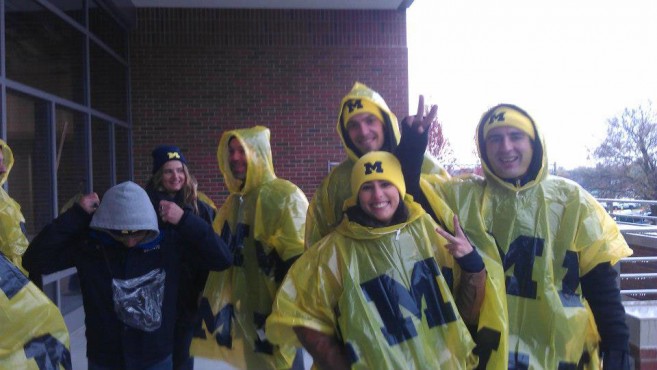
Théâtre de la Ville at the Michigan game
Rhinos at the U-M Cube
We’ve been seeing a stampede of rhinos in Ann Arbor. See Théâtre de la Ville perform Ionesco’s Rhinocéros in Ann Arbor, October 11-13 at the Power Center.
Rhinocéros by Eugène Ionesco, a man among his ex-peers
Editor’s Note: Théâtre de la Ville perform Rhinocéros, a seminal theater of the absurd play, this October.
Sometimes, absurdity makes much sense.
In a peaceful village somewhere in France, a cat is being run over by a rhino. The rhino is a special one: not a wild, exotic animal escaped from a zoo, but some sort of a “human-rhino,” a human being turned into a beast. The political farce at stake in Ionesco’s play Rhinocéros is about the humanity of this inhuman epidemic through which almost everybody converts to the rhino-mania.
Beyond the absurdity of the improvisation of this rhino-circus lies the fable of resistance and conformity, or, to put it into perspective, the resistance to the pressure of conformity. But when everyone hurries to wear the same uniform, this rush to conform can actually trigger a minor, yet heroic counter-transition: from coward and anonymous character to brave and committed humanist. Such is the case of Bérenger, an insignificant employee on the verge of either alcoholism or existential vertigo (maybe both), who comes out as an unexpected résistant when everything around him urges him to become a rhino.
The theater of the absurd is subject to many interpretations, and most commentators have praised this play for its creative critique of the rise of totalitarianism. Some have specifically seen a reference to the Vichy episode (1940-1944), when the majority of French accepted collaboration with Nazi Germany. This massive collaboration was so degrading and disgraceful for the myth of France fighting fascism that, that, once Hitler was defeated, French people rephrased History and reinvented themselves as a nation of résistants during the collaboration – a case of bad consciousness, as would say Sartre.
A more personal interpretation is that Ionesco, as he was living in Romania during the 30s, witnessed the rise of a xenophobic, nationalist and anti-Semitic movement, the Garda de Fier (the Legionary Movement), which repelled him and made him consider France as a land of escape. Ionesco was deeply hurt and confused by the fact that his close friends, Emil Cioran and Mircea Eliade, became enthusiastic about the Legionary Movement. Once they would gather again, this time in Paris after WW2, Cioran and Eliade would hide their embarrassing past and Ionesco would not mention or write explicitly about their former “political fever.” In this perspective, the play Rhinocéros, published in 1959, might be his personal meditation on the loneliness and the legitimacy of the one who resists until the end against all the others, including his friends.
Unfortunately, nowadays, the rhinos depicted by Ionesco are not an endangered species, and Ionesco’s fable about the tensions between resistance and conformity continues to speak to a large audience worldwide.
At some point, if not every day, one finds himself at the crossroad between the temptation to fit the rhino-mania of his times and the interior duty to fight against the normalization of minds and actions. The last sentences “Je suis le dernier homme, je le resterai jusqu’au bout ! Je ne capitule pas !” (“I am the last human, and will remain so until the end. I don’t surrender!”) cannot fail to strike us by its invigorating humanism.


